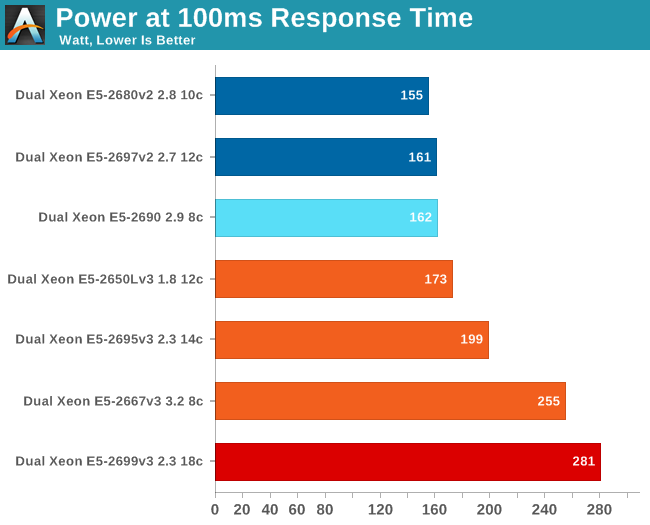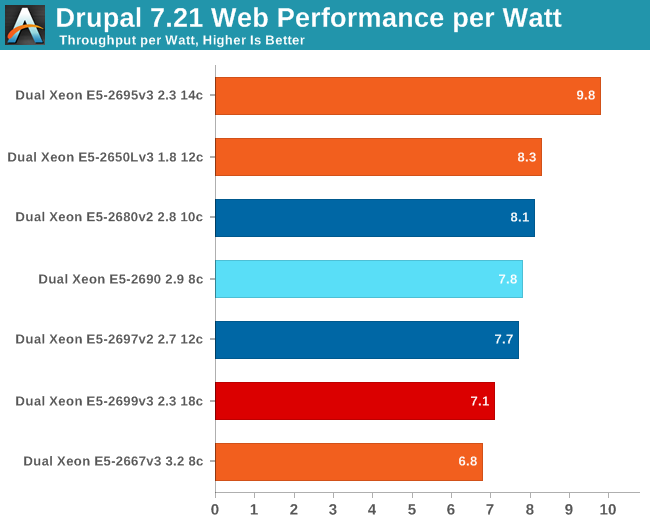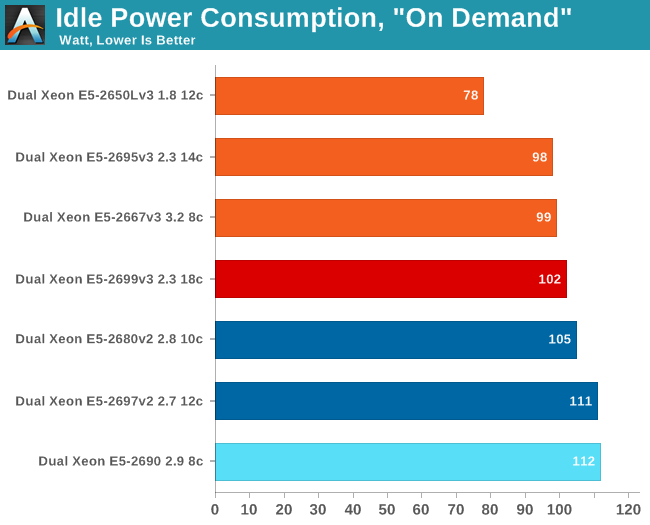Intel Xeon E5 Version 3: Up to 18 Haswell EP Cores
by Johan De Gelas on September 8, 2014 12:30 PM ESTDrupal Website: Performance per Watt
When we reviewed the Xeon E5-2600 v2, a performance per watt comparison was much more straightforward. Now we are faced with two different 2U-servers, with many similarities but also with some noteworthy differences. For example, the E5-2600 v3 based server is outfitted with six fans that can pull 1.6A, while our Xeon E5-2600 v2/v1 based server is outfitted with three fans that can pull 0.6A. If all fans are at their maximum RPM, the fans of the first server could easily pull 90W more. Also, our "Wildcat Pass" server still has to mature a bit as we are using a beta BIOS that has quite a few issues. Still, at idle, both servers are in the same ballpark.
The Haswell-EP reveals its mobile roots. The Idle power of the Xeon E5-2699 v3 is lower despite being a much larger chip than the Xeon E5-2697 v2, while both are baked upon the same process technology.
Next we measure the power consumed while keeping the response time at 100 ms. These are averages measured over a period of time. So basically we are measuring energy consumption, but we report the average power that was consumed over the same period of time.

It would be wrong to simply compare the numbers above as the Xeon E5-2695 and 2699 do considerably more work. However, it cannot be denied that the Xeon E5-2699 v3 and Xeon E5-2667 v3 are a lot more power hungry than the rest of the pack. Remember also that, as noted above, the fans of the server that hosted the Xeon E5 v3 consume quite a bit more, but at the moment we have not been able to determine how much.
Let's calculate performance per watt. Take the following graph with a grain of salt as the benchmark is not the most accurate (results tend to vary by 5-8%), but still it gives a rough idea of what you can expect.

The Xeon E5-2695 v3 is able to Turbo Boost to high clock speeds, which keeps the response time low. At the same time, the power consumption is limited. The Xeon E5-2699 v3 probably fires up the fans a lot higher, and that drives power consumption up as the fans in our server can consume quite a bit.
What this means is that TDP is once again a relatively decent predictor of actual power consumption. The lower TDP of the Xeon E5-2695 v3 (120w) materializes in real world power savings compared to the Xeon E5-2667 v3 (135W TDP) and Xeon E5-2699 v3 (145W TDP).











85 Comments
View All Comments
bsd228 - Friday, September 12, 2014 - link
Now go price memory for M class Sun servers...even small upgrades are 5 figures and going 4 years back, a mid sized M4000 type server was going to cost you around 100k with moderate amounts of memory.And take up a large portion of the rack. Whereas you can stick two of these 18 core guys in a 1U server and have 10 of them (180 cores) for around the same sort of money.
Big iron still has its place, but the economics will always be lousy.
platinumjsi - Tuesday, September 9, 2014 - link
ASRock are selling boards with DDR3 support, any idea how that works?http://www.asrockrack.com/general/productdetail.as...
TiGr1982 - Tuesday, September 9, 2014 - link
Well... ASRock is generally famous "marrying" different gen hardware.But here, since this is about DDR RAM, governed by the CPU itself (because memory controller is inside the CPU), then my only guess is Xeon E5 v3 may have dual-mode memory controller (supporting either DDR4 or DDR3), similarly as Phenom II had back in 2009-2011, which supported either DDR2 or DDR3, depending on where you plugged it in.
If so, then probably just the performance of E5 v3 with DDR3 may be somewhat inferior in comparison with DDR4.
alpha754293 - Tuesday, September 9, 2014 - link
No LS-DYNA runs? And yes, for HPC applications, you actually CAN have too many cores (because you can't keep the working cores pegged with work/something to do, so you end up with a lot of data migration between cores, which is bad, since moving data means that you're not doing any useful work ON the data).And how you decompose the domain (for both LS-DYNA and CFD makes a HUGE difference on total runtime performance).
JohanAnandtech - Tuesday, September 9, 2014 - link
No, I hope to get that one done in the more Windows/ESXi oriented review.Klimax - Tuesday, September 9, 2014 - link
Nice review. Next stop: Windows Server. (And MS-SQL..)JohanAnandtech - Tuesday, September 9, 2014 - link
Agreed. PCIe Flash and SQL server look like a nice combination to test this new Xeons.TiGr1982 - Tuesday, September 9, 2014 - link
Xeon 5500 series (Nehalem-EP): up to 4 cores (45 nm)Xeon 5600 series (Westmere-EP): up to 6 cores (32 nm)
Xeon E5 v1 (Sandy Bridge-EP): up to 8 cores (32 nm)
Xeon E5 v2 (Ivy Bridge-EP): up to 12 cores (22 nm)
Xeon E5 v3 (Haswell-EP): up to 18 cores (22 nm)
So, in this progression, core count increases by 50% (1.5 times) almost each generation.
So, what's gonna be next:
Xeon E5 v4 (Broadwell-EP): up to 27 cores (14 nm) ?
Maybe four rows with 5 cores and one row with 7 cores (4 x 5 + 7 = 27) ?
wallysb01 - Wednesday, September 10, 2014 - link
My money is on 24 cores.SuperVeloce - Tuesday, September 9, 2014 - link
What's the story with 2637v3? Only 4 cores and the same freqency and $1k price as 6core 2637v2? By far the most pointless cpu on the list.